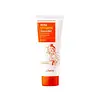What's inside
What's inside
 Key Ingredients
Key Ingredients

 Benefits
Benefits

 Concerns
Concerns

 Ingredients Side-by-side
Ingredients Side-by-side

Water
Skin ConditioningCocamidopropyl Betaine
CleansingGlycerin
HumectantAcrylates Copolymer
1,2-Hexanediol
Skin ConditioningSodium Chloride
MaskingCoptis Japonica Root Extract
Skin ConditioningHippophae Rhamnoides Extract
MaskingSalicylic Acid
MaskingAscorbic Acid
AntioxidantAcrylates/C10-30 Alkyl Acrylate Crosspolymer
Emulsion StabilisingTromethamine
BufferingChlorhexidine Digluconate
AntimicrobialCitrus Paradisi Peel Oil
MaskingLimonene
PerfumingWater, Cocamidopropyl Betaine, Glycerin, Acrylates Copolymer, 1,2-Hexanediol, Sodium Chloride, Coptis Japonica Root Extract, Hippophae Rhamnoides Extract, Salicylic Acid, Ascorbic Acid, Acrylates/C10-30 Alkyl Acrylate Crosspolymer, Tromethamine, Chlorhexidine Digluconate, Citrus Paradisi Peel Oil, Limonene
Water
Skin ConditioningCoco-Betaine
CleansingDisodium Cocoamphodiacetate
CleansingGlycerin
HumectantSodium Chloride
MaskingPotassium Cocoyl Glycinate
Acrylates Copolymer
1,2-Hexanediol
Skin ConditioningPolyglyceryl-10 Laurate
Skin ConditioningCeramide As
Skin ConditioningCeramide AP
Skin ConditioningCeramide EOP
Skin ConditioningCeramide NP
Skin ConditioningCeramide Ns
Skin ConditioningAscorbic Acid
AntioxidantPhytosphingosine
Skin ConditioningMyrothamnus Flabellifolia Leaf/Stem Extract
HumectantHydrogenated Lecithin
EmulsifyingCetearyl Alcohol
EmollientStearic Acid
CleansingPropanediol
SolventXanthan Gum
EmulsifyingEthylhexylglycerin
Skin ConditioningDisodium EDTA
Hexylene Glycol
EmulsifyingCholesterol
EmollientCitric Acid
BufferingBetaine
HumectantSodium Citrate
BufferingWater, Coco-Betaine, Disodium Cocoamphodiacetate, Glycerin, Sodium Chloride, Potassium Cocoyl Glycinate, Acrylates Copolymer, 1,2-Hexanediol, Polyglyceryl-10 Laurate, Ceramide As, Ceramide AP, Ceramide EOP, Ceramide NP, Ceramide Ns, Ascorbic Acid, Phytosphingosine, Myrothamnus Flabellifolia Leaf/Stem Extract, Hydrogenated Lecithin, Cetearyl Alcohol, Stearic Acid, Propanediol, Xanthan Gum, Ethylhexylglycerin, Disodium EDTA, Hexylene Glycol, Cholesterol, Citric Acid, Betaine, Sodium Citrate
 Reviews
Reviews

Ingredients Explained
These ingredients are found in both products.
Ingredients higher up in an ingredient list are typically present in a larger amount.
1,2-Hexanediol is a synthetic liquid and another multi-functional powerhouse.
It is a:
- Humectant, drawing moisture into the skin
- Emollient, helping to soften skin
- Solvent, dispersing and stabilizing formulas
- Preservative booster, enhancing the antimicrobial activity of other preservatives
Acrylates Copolymer is used as a film-forming agent and texture enhancer.
After applied, Acrylates Copolymer forms a thin film cover that helps skin feel more soft. It can help sunscreens become more water-resistant.
It is also used to make a product more thick.
Learn more about Acrylates CopolymerAscorbic Acid is is pure Vitamin C. This form makes up the largest amount of vitamin C found naturally in our skin.
Not only is vitamin C great for your overall health and immune system, it also has plenty of benefits on your skin.
Vitamin C is best used for brightening skin. It improves dark spots, acne scars, and hyperpigmentation. This is because it blocks the process of skin darkening when exposed to UV.
Remember: Vitamin C should not replace sunscreen!
Your skin uses vitamin C to build collagen. Collagen is one key component in having a strong skin barrier and plump skin. Vitamin C also plays a role in regulating collagen, thus making it effective in improving wrinkles and fine lines.
Ascorbic acid shows potent antioxidant activity. As an antioxidant, it helps fight free-radicals. Free-radicals are molecules that may damage your skin cells. These antioxidants also protect skin against UV damage.
The best formulations include Vitamin E and/or ferulic acid. These two ingredients help stabilize and provide a boost in the benefits of ascorbic acid. This is because ascorbic acid becomes unstable when exposed to UV and air. In fact, you can tell your ascorbic acid has oxidized when it turns an orange-yellow color.
Ascorbic acid is generally compatible with other ingredients. However, using ascorbic acid with other active ingredients might cause irritation. Two ingredients: copper ions and benzoyl peroxide, will inactivate ascorbic acid completely.
Read more about other types of Vitamin C:
Foods rich with vitamin C include oranges, strawberries, broccoli, bell peppers, and more. When consuming Vitamin C, your skin receives a portion of the nutrients.
Learn more about Ascorbic AcidGlycerin is already naturally found in your skin. It helps moisturize and protect your skin.
A study from 2016 found glycerin to be more effective as a humectant than AHAs and hyaluronic acid.
As a humectant, it helps the skin stay hydrated by pulling moisture to your skin. The low molecular weight of glycerin allows it to pull moisture into the deeper layers of your skin.
Hydrated skin improves your skin barrier; Your skin barrier helps protect against irritants and bacteria.
Glycerin has also been found to have antimicrobial and antiviral properties. Due to these properties, glycerin is often used in wound and burn treatments.
In cosmetics, glycerin is usually derived from plants such as soybean or palm. However, it can also be sourced from animals, such as tallow or animal fat.
This ingredient is organic, colorless, odorless, and non-toxic.
Glycerin is the name for this ingredient in American English. British English uses Glycerol/Glycerine.
Learn more about GlycerinChances are, you eat sodium chloride every day. Sodium Chloride is also known as table salt.
This ingredient has many purposes in skincare: thickener, emulsifier, and exfoliator.
You'll most likely find this ingredient in cleansers where it is used to create a gel-like texture. As an emulsifier, it also prevents ingredients from separating.
There is much debate on whether this ingredient is comedogenic. The short answer - comedogenic ratings don't tell the whole story. Learn more about comegodenic ratings here.
The concensus about this ingredient causing acne seems to be divided. Research is needed to understand if this ingredient does cause acne.
Scrubs may use salt as the primary exfoliating ingredient.
Learn more about Sodium ChlorideWater. It's the most common cosmetic ingredient of all. You'll usually see it at the top of ingredient lists, meaning that it makes up the largest part of the product.
So why is it so popular? Water most often acts as a solvent - this means that it helps dissolve other ingredients into the formulation.
You'll also recognize water as that liquid we all need to stay alive. If you see this, drink a glass of water. Stay hydrated!
Learn more about Water